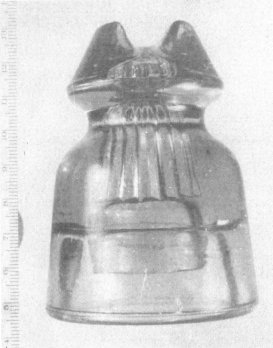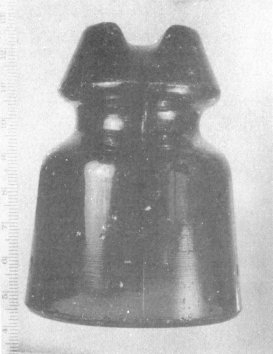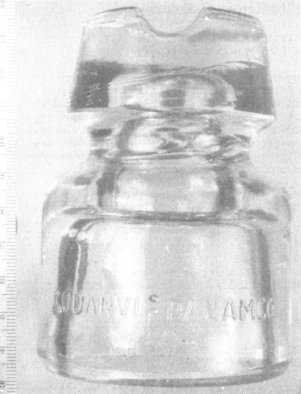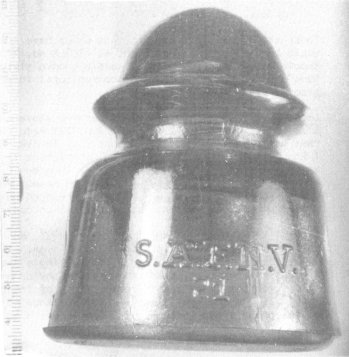Glass Insulators In Uruguay
by Jose Luis Rubio Box 538, Montevideo, Uruguay
Reprinted from "INSULATORS - Crown Jewels of the Wire", December 1972, page 2
All of you know that Uruguay is the smallest country in South America,
located on the Atlantic Coast between Argentina and Brazil. Glass insulators are
rare here, since porcelain insulators were used on most of the lines. However, it seems I am the only collector in this country. Other glass items are
collected, such as old bottles and piano coasters; but glass insulators are
still not considered collectible items. They are sold as decorative trinkets at
antique shops.
Our glass insulators an be divided into two classes: Imported. These were
brought if through the years. The following have been found:
|
CD 102 F. (W.BROOKFIELD) B. (NEW YORK) smooth base, aqua.
|
|
CD 115 F.
(HEMINGRAY-10) B. (MADE IN U.S.A.) rd. drips, aqua.
|
|
CD 152 F. (HEMINGRAY) B. (No
40) sharp drips, green.
|
|
CD 154 F. (GAYNER) B. (MADE IN U.S.A. No 44) sharp
drips, aqua.
|
|
CD 154 F. (HEMINGRAY-42) B. (MADE IN U.S.A.) rd. drips, clear.
|
|
CD
154 F. (HEMINGRAY-42) B. (MADE IN U.S.A.) rd drips green.
|
|
CD 155 F. (WHITALL
TATUM No 1) B. (MADE IN U S.A. smooth base, clear.
|
|
CD 208 F. (HEMINGRAY MADE IN U.S.A.) B. (No 44) sharp drips, green
|
|
CD 119 F. (W.BROOKFIELD.N.Y.) B. (PAT. APRIL 28 1885) smooth base, aqua.
|
|
CD 119 F. (W.BROOKFIELD.N.Y.) B. (PAT. APRIL 28 1885) smooth base, light
green.
|
|
CD 119 F. (W.BROOKFIELD.N.Y.) B. (PAT. APRIL 28 1885) smooth base, green.
|
There are other imported specimens which have no CD number and would be
difficult to describe, as ISOREX No. 232 deep green, smooth base, double
petticoat saddle groove style; and another "No Name" which has instead of the
conventional thread 16 vertical grooves (see photo).
 No Name
No Name
 ISOREX Fac. #232 deep green 2 P. smooth base
ISOREX Fac. #232 deep green 2 P. smooth base
Local. This class of insulators for the above-mentioned reason is also rare.
There were two factories that made them here. One of them was CODARVI-PANAMCO,
who made them in clear glass (as far as I know). The other is S.A.F.N.V.,
characters that stand for Corp. National Glass Factory, who made them in green
shades. Insulators of both companies were made with smooth bases; and although
design differ somewhat from each factory, corresponding sizes have the same
style number as these were produced on contract.
CODARVI-PANAMCO made Numbers 21, 22, and 23, and No. 21 being the largest
size, approximately four inches high. I also have in the collection an
unembossed No. 22, this being a specimen of the first production (experimental)
run. I also know of a specimen of No. 22P, which has a small petticoat. It is of
interest to note that No. 23 is the smallest glass insulator I know of that has been used on
telephone lines, only about 2-3/8 inches high! The same is true for S.A.F.N.V.
No. 23 which, although it has a slightly wider skirt, is approximately the same
height.
 F. (CODARVI-PANAMCO 69)
B. (IND. URUGUAYA)
Fac. #21, clear, smooth base F. (CODARVI-PANAMCO 69)
B. (IND. URUGUAYA)
Fac. #21, clear, smooth base
 F. (S.A.F.N.V. 21)
B. (2)
green, smooth base F. (S.A.F.N.V. 21)
B. (2)
green, smooth base
S.A.F.N.V. In addition to Numbers 21, 22 and 23, this company made an
insulator which corresponds to a North American design (CD #128)
"CSC". insulators are embossed CSC.
Another that I consider included in this group, although imported, is C.T.R.G.,
characters that stand for Rio Grande Telephone Company of Southern Brazil, with
which our country was connected before modern techniques of communication. This
old insulator, in deep green color, is similar to CD 106.
 F. (C.Y. R.G.)
B. (No 9)
drip points, deep green, CD 106
F. (C.Y. R.G.)
B. (No 9)
drip points, deep green, CD 106
Short History of the Beginning of the Telephone in Uruguay
Captain Benjamin D. Manton was born in Providence, R. I., on May 10, 1829,
and was in charge of the U. S. Consulate at the city of Colonia, Uruguay, from
1868 until that office was closed in 1907. Captain Manton is considered the
father of the telephone in this area. On January 16, 1881, he was granted a
permit to install a telephone exchange in Montevideo. The next year he sold his
rights to the English company named "The River Plate Telephone and Electric
Light Company", better known here and in Argentina as "The Gower-Bell
Company", because of the systems used. A publication printed in 1884 states
that the Gower-Bell Company used a Hughes microphone with the Bell phone. There
were 700 miles of line in those days.
In 1882 another telephone permit was granted to Mr. Ed Jackson, who sold it
to Porrit and Company. This was incorporated in 1884 under the name of "La
Uruguay", which means in English "The Uruguayan", although most
of the founders were of American origin, as Mr. J. K. Theobald, Mr. Ed Jackson
and Mr. Thomas W. Porrit. The extent of the lines of this company in 1884 was
1,473 miles. Both companies, "The River Plate Telephone and Electric
Company", and "La Uruguaya", continued operating until July 31,
1888, when "The Montevideo Telephone Company, Ltd." bought them.
The Montevideo Telephone Company, Ltd., operated Montevideo phones until
October 12, 1933, when they sold this part of the company to our Government
which is still operating them under the characters "U.T.E." The
Montevideo Telephone Company continued giving service in the rural areas until
July 31, 1946, when they sold the rest of the lines to U.T.E.
In 1889 another telephone company was founded. This was the "Sociedad
Cooperativa Telefonica Nacional", which means in English "National
Cooperative Telephone Society". It operated in the city of Montevideo until
October 12, 1933.
In March of 1887 an operating permit was requested by the "Compania Telegrafica-Telefonica del Plata", which means in English, "Telegraph and Telephone Company of the River of la Plata". (Or."River
Plate" as it is occasionally called in English). This company connected our
country with Argentina. Their system consisted of a pole line to the city of
Colonia, which is just across the river from Buenos Aires, Argentina. From the
city of Colonia to a place on the Argentine side called Punta Lara, they laid a
submerged cable; and from there to Buenos Aires a pole line. Please take note
that our River is the widest in the world; and although we cannot determine
precisely the length of this cable, no doubt it was a great accomplishment for
those days. On November 1, 1889, this line was completed.
|
